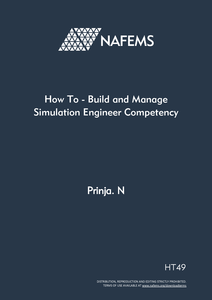
With the advent of more powerful computers, the application of computational mechanics has gained widespread acceptance in engineering companies involved in the design and analysis of engineering components and structures. There are many commercially available computer codes which run on a wide range of computer hardware to analyse the behaviour of a structure or a component under various loading conditions. It is not the computers that solve engineering problems though. A typical problem is formulated into a mathematical model which is run by computers and the solution must be subjected to an engineering appraisal; hence, the need to have a professional simulation engineer to perform such a design and analysis process. This publication highlights the issues related to the process of establishing competency in simulation engineering.
Contents
| 1. Introduction | 1 |
| 2. Definition of Competency | 3 |
| 3. Need for Competency | 5 |
| 4. Industry Sectors Requiring Competency Management | 7 |
| 5. Levels of Competency | 9 |
| 6. Areas of Competency | 11 |
| 7. Steps to Building Competency | 13 |
| 8. Competency Register | 15 |
| 9. Competency Management Process | 17 |
| 10. Advantages of a Competency Management Process | 23 |
| 11. Examples of Competency Framework | 25 |
| 12. References | 27 |
| 13. NAFEMS PSE Competencies Covered In This Publication | 29 |



